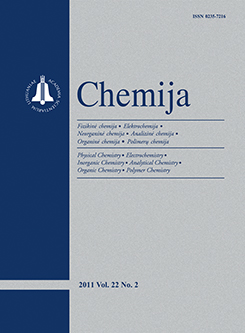Chemija / Chemistry
WHAT?
 ISSN 0235-7216 ISSN 2424-4538 (online) |
2017 m. Nr. 1 Varieties and chemical composition of magnetite in the Varėna Iron Ore Deposit
Magnetites of the Varėna Iron Ore Deposit (VIOD) were thoroughly investigated by the Cameca SX-100 microprobe at the Warsaw University and by the Quanta 250 Energy Dispersive Spectroscopy (EDS) at the Nature Research Centre in Vilnius, Lithuania. Four generations of magnetite were distinguished in the studied serpentine–magnetite ores (D8 drilling). The earliest, spinel inclusion-rich magnetite cores (Mag-1) might have formed during an early metamorphism and/or related skarn formation. They have the highest trace element (Si, Al, Mg, Ti, V, etc.) contents. Voluminous second magnetite (Mag-2) had replaced olivine, pyroxenes, spinel and other skarn minerals at c. 540 °C (Mag–Ilm geothermometer) and has trace elements washed out by hydrothermal fluids. The latest magnetites (Mag-3 and Mag-4) originated from the late thermal reworking by dissolution–reprecipitation processes. Some of the latest magnetites (Mag-4) are mostly related to the sulfide veins. As concerning the origin of the studied magnetites, they have similar trace element abundances as skarn magnetites, are in general Ti-poor. The Mag-1 is more than twice richer in Mg than the porphyry and Kiruna type iron ores. A slight enrichment in Al, Ti and V because of spinel and ilmenite inclusions may have caused the earliest Mag-1 to resemble the porphyry type ores, while the secondary Mag-2 has Al, Ca and Mn contents as low as the Kiruna type ores. Even though there are no precise age constructions for the iron ore formation process, it may be related to metamorphic, metasomatic and later hydrothermal processes, the last of which is assumed to have occurred during the c. 1.50 Ga within-plate AMCG magmatism.
: Keywords: Varėna Iron Ore Deposit, metasomatism, magnetite chemistry, ore chemistry, scanning electron microscopy, Precambrian, crystalline basement |
Issues:
2017 - Vol.28 No. 1, No. 2, No. 3, No. 4 2016 - Vol.27 No. 1, No. 2, No. 3, No. 4 2015 - Vol.26 No. 1, No. 2, No. 3, No. 4 2014 - Vol.25 No. 1, No. 2, No. 3, No. 4 2013 - Vol.24 No. 1, No. 2, No. 3, No. 4 2012 - Vol.23 No. 1, No. 2, No. 3, No. 4 2011 - Vol.22 No. 1, No. 2, No. 3, No. 4 2010 - Vol.21 No. 1, No. 2-4 2009 - Vol.20 No. 1, No. 2, No. 3, No. 4 2008 - Vol.19 No. 1, No. 2, No. 3-4 2007 - Vol.18 No. 1, No. 2, No. 3, No. 4 2006 - Vol.17 No. 1, No. 2-3, No. 4 2005 - Vol.16 No. 1, No. 2, No. 3-4 2004 - Vol.15 No. 1, No. 2, No. 3, No. 4 2003 - Vol.14 No. 1, No. 2, No. 3, No. 4 2002 - Vol.13 No. 1, No. 2, No. 3, No. 4 2001 - Vol.12 No. 1, No. 2, No. 3, No. 4 |